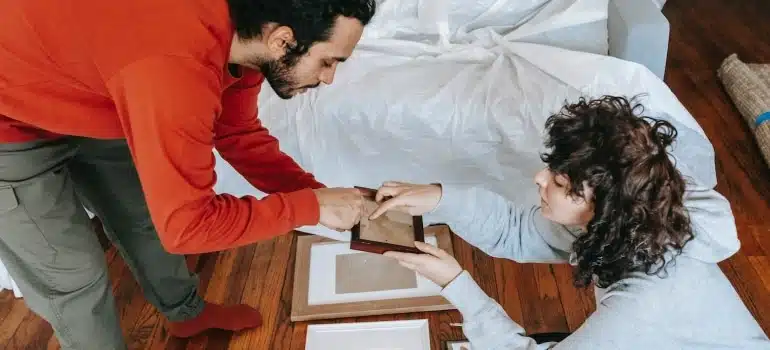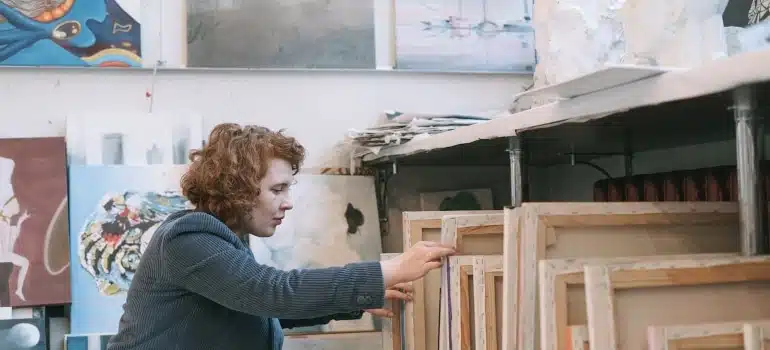Packing paintings and canvases when moving to Florida
Art lovers relocating to Florida often worry about how to pack paintings and canvases safely. Artwork can be delicate, high in value, and emotionally significant. Florida’s humidity, heat, and long transport distances only increase the risks. Even short trips can result in warped frames, cracked paint, or torn canvas without the right approach. This guide by expert Miami movers covers preparing, packing, transporting, and storing artwork correctly. You’ll learn best practices for various art types, when to use professional help, what materials to choose, and how to avoid common mistakes when packing paintings and canvases.
Why proper packing matters for artwork in Florida
Artwork that isn’t packed properly is vulnerable to heat, vibration, moisture, and impact. In Florida, high humidity can soften glue, damage paper, and cause mildew. Paintings exposed to heat may warp or crack. Without proper protection, even short moves across town can cause permanent damage.
Packing properly protects more than just the physical surface. Many paintings are one-of-a-kind, hold sentimental value, or represent a major financial investment. The cost of professional packing is small compared to the potential loss from avoidable damage.
Experienced movers in Florida understand local conditions and use materials and methods tailored to the region’s climate. They help ensure that paintings and canvases arrive safely, even during long-distance or international relocations.

Materials to use when packing paintings and canvases
Every piece of artwork needs a thoughtful packing plan and reliable materials. Florida conditions make this especially important. Begin with clean, dry hands or wear gloves when handling art.
Use the following packing materials to prepare each piece:
- Acid-free tissue paper or glassine to protect painted or printed surfaces
- Foam sheets or bubble wrap for cushioning
- Flat, rigid boxes or mirror cartons sized to the artwork
- Packing peanuts or crumpled kraft paper to fill gaps
- Corner protectors to prevent edge crushing
- Desiccant packets to absorb moisture
- Painter’s tape to secure wraps without damaging surfaces
- Custom-built crates for large or high-value items
Custom-sized boxes or crates provide the best fit. Gaps between the artwork and the box lead to unnecessary movement and damage during transit. Avoid loose packing and secure everything snugly with soft materials that won’t press or rub against the artwork. Also, securing professional white glove packing assistance makes sense when you’re moving large, antique, or high-value artwork.
How to prepare paintings and canvases before packing
Before packing begins, artwork must be clean, dry, and stabilized. Preparation reduces the risk of damage and makes the packing process more efficient. Follow these key steps to get your artwork ready:
- Dust gently using a soft-bristled brush
- Avoid moisture by keeping all surfaces dry and clean
- Wear gloves or use clean hands to prevent oils from transferring
- Inspect each piece for existing damage or fragile points
- Document condition with photos for inventory and insurance
- Remove any loose items like hanging hardware or glass that may shift during transport
- Measure each piece to match it with the right box or crate size
Store artwork in a cool, shaded area until packing begins. High temperatures and humidity, even for a short period, can weaken materials and increase risks during transit.
How to pack canvas paintings for moving
Canvas paintings require protection for both the painted surface and the frame. Start by wrapping the front of the canvas in glassine paper or acid-free tissue paper. Avoid contact between painted surfaces and plastic materials, as these can stick to paint in hot weather.
Once the surface is protected, add a layer of foam or bubble wrap. Be careful not to press the wrap directly against the painted area if it’s not already covered in glassine. Secure the wrap using painter’s tape.
Slide the protected painting into a flat, rigid box or mirror carton. If the fit is loose, fill gaps with crumpled kraft paper or foam. Avoid packing multiple canvases in the same box unless separated with foam board. Place corner protectors on framed edges before boxing.
Store all canvas paintings upright during the move. Lying them flat increases the chance of pressure damage or bending.
How to pack watercolor paintings
Watercolors are especially vulnerable to moisture and surface damage when. When packing paintings for moving, always apply a fixative spray to reduce the risk of smudging. Wait until the fixative dries fully before wrapping.
Wrap the artwork in acid-free tissue paper, followed by a second layer of foam or light bubble wrap. Do not allow the wrap to contact the painting directly without the tissue paper. Place it in a flat, rigid box with soft filling around the edges.
If your watercolor is behind glass, tape the glass in an X pattern with painter’s tape to prevent shattering. Add foam padding to the front and back before boxing.

How to pack stretched and unstretched canvases
Stretched canvases require both surface and frame protection. Wrap the painted area in glassine or acid-free tissue, add bubble wrap or foam, and then place the entire piece in a flat box. Add corner protectors and filler around all sides to prevent movement.
Unstretched canvases can be rolled instead of boxed. Start with a layer of glassine or acid-free tissue paper on the painted side, roll carefully with the artwork facing outward, and secure with soft ties. Place the rolled piece in a wide mailing tube or a box with soft padding.
How to pack framed and antique artwork
Framed artwork, especially pieces with glass, requires extra caution. Tape the glass surface to contain breakage, wrap in acid-free paper, and add padding layers with foam or bubble wrap. Place the entire piece in a snug box, then fill all gaps around the frame.
Antique paintings are more sensitive to vibration, moisture, and handling. Use foam board or a hard backing behind the artwork to reduce stress during movement. For high-value antiques, always request custom crating and climate-controlled transport. Professional antique movers with experience in antique handling can reduce the risk of costly damage.
How to pack acrylic, mixed media, and pastel artwork
Acrylic paintings are more durable than oils but still need protection from heat and pressure. The surface can soften in high temperatures and stick to plastic wrap. To prevent this, place a layer of glassine or acid-free paper over the painted surface, then add foam or bubble wrap. Avoid letting the wrap touch the paint directly. Use a rigid box or mirror carton with filler to stabilize the piece during transport.
Mixed media or textured artwork requires extra care to avoid crushing raised or layered elements. Spacers can help prevent contact with the surface. Place the artwork in a deep, padded box or custom crate that allows breathing room. Avoid stacking anything on top, and clearly label the box as fragile and top-loaded only.
Pastel and charcoal drawings can smudge easily, even with fixative. Always place glassine directly against the drawing surface, not tissue paper. Sandwich the piece between two rigid boards, then wrap the package and place it inside a snug box. This method prevents both surface contact and bending during the move.
Common mistakes to avoid when packing paintings and canvases
Even with good materials, some practices put artwork at serious risk. Avoid wrapping any piece directly in plastic. This traps moisture and can soften paint or paper, especially in Florida’s humidity.
Skip the newspaper as a wrapping material. Ink can transfer and stain the artwork permanently. Don’t stack artwork without padding between each piece. Paintings and frames rubbing together can chip, flake, or break.
Store all paintings upright, not flat. Canvases stored horizontally are more likely to sag, bend, or collapse under pressure. Avoid over-packing boxes with multiple items unless they are separated with padding and clearly labeled.

How to protect paintings and canvases during transport
Even perfectly packed artwork needs careful handling during loading and transport. Always load paintings upright and secure them with straps or padded anchors inside the truck. Avoid laying anything flat unless it’s boxed and stabilized.
In Florida, heat can build up quickly inside vehicles. Move early in the morning or late in the afternoon when temperatures are lower. Use thermal insulation materials or padded blankets around boxes to reduce heat absorption.
Choose luxury movers with climate-aware practices and trained crews. Otherwose, if any damage occurs during the move, document it immediately with photos, note the time and condition, and file a claim with the moving company.
How do you travel with canvas paintings?
Transporting canvas paintings in your own vehicle gives you more control, but still requires preparation. Use a rigid portfolio case or padded folder for small or medium pieces. Place larger framed canvases upright on a soft, flat surface in the back seat or trunk with the back of the frame facing outward.
Avoid direct sunlight or placing art in a hot car, especially if you plan to leave it unattended. Never put artwork in the trunk of a vehicle on a hot day without climate control. Avoid stacking anything on top of a canvas, even temporarily.
Secure paintings to prevent sliding or falling during turns. If you’re flying, bring small works as carry-on in a flat folder. Airlines usually allow flat packages under standard limits, but always check ahead of time.
How does packing paintings and canvases work for international shipping
International moves require extra packing steps due to time, handling, and customs. When packing paintings for shipping that involve wood materials, always use ISPM-15 certified wood crates. Start with wrapping the artwork in acid-free paper, followed by foam or bubble wrap.
Double-boxing adds another layer of safety when packing paintings for moving. Place the artwork in a snug interior box, then insert that box into a second, slightly larger one filled with foam or packing peanuts. Use shock and humidity indicators on the outside of the crate when needed.
Include desiccant packs to absorb moisture inside the crate, and label with international handling instructions like “Fragile,” “Do Not Stack,” and “Keep Upright.” Keep an inventory list with condition photos for customs and insurance.
Long-term Miami storage for paintings and canvases
Paintings placed in Miami storage need the same level of care as they do during transit. Clean each piece gently, apply a protective wrap of glassine or tissue paper, and add padding. Place the artwork in a box or crate, upright and labeled.
Choose a climate-controlled storage unit to avoid exposure to temperature swings and humidity. Florida storage units without climate control can lead to warping, mildew, or adhesive failure. Avoid plastic wrap for long-term storage. Breathable materials prevent trapped moisture and mold growth.
Reputable storage units Miami area offer climate-controlled storage solutions designed for fine art. Many provide on-demand access, custom shelving, and inventory tracking.

Use moving insurance for peace of mind
Standard homeowner’s insurance usually doesn’t cover damage during a move. Even movers’ basic coverage often reimburses based on weight rather than value. That’s why moving insurance designed for fine art is essential.
Request full-value replacement coverage or declare each item’s value in writing. Keep your receipts, appraisals, and photographs on file before the move. If you’re using a professional mover, ask what types of insurance they offer and what documentation is needed to file a claim.
When to hire professional art movers
Some moves make professional help not just helpful, but necessary. Local fine art movers have the tools and training to manage complex situations. You’ll likely need professional support in these scenarios:
- Relocating antique or museum-quality pieces
- Moving more than five framed or oversized artworks
- Shipping art internationally or across state lines
- Needing climate-controlled storage or trucks
- Lacking time, materials, or experience to pack safely
Hiring professionals when packing paintings for moving adds cost, but it prevents loss and gives peace of mind. Pro Movers Miami specialize in handling artwork under Florida’s tough conditions and can tailor services to meet your needs.
Choosing safety and care for your artwork
Protecting paintings and canvases during a move takes more than basic packing. Florida’s heat, humidity, and long distances increase the risk of damage. Using the right materials, preparing each piece properly, and avoiding common mistakes all help reduce that risk.
Pro Movers Miami has the experience and tools to keep your collection safe during packing, transport, and storage. Whether you’re relocating locally or across borders, relying on skilled movers for packing paintings and canvases ensures artwork stays protected from start to finish.
